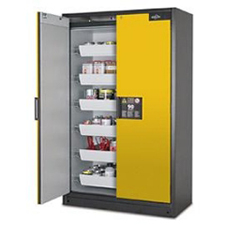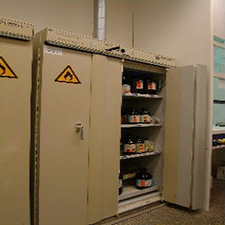Page content
Standard Storage Cabinet
A standard cabinet is a separate cabinet with doors. No ventilation or extra fire resistance available. Dry chemicals can be stored in these with the exception of: toxic, flammable, explosive, oxidizing and water-reactive substances.
Chemical Cabinet

A chemical cabinet has a light extraction but no fire resistance. For example, the base cabinets of fume hoods that are connected to the extraction of the fume hood. Irritating and/or harmful substances can be stored in this. Corrosive substances such as acids and alkalis may also be included, but only in separate drip trays. If the shelf is also a drip tray, place the different groups of fabrics on their own shelf, separate from each other. A closed poison cabinet may be placed in a fire safety cabinet if the poison cabinet is separated from the other substances.
Fire safety cabinet

A fire safety cabinet has a minimum fire resistance of 60 minutes. The cabinet is equipped with extraction. It can store highly flammable, highly flammable products such as ether, alcohol, acetone and xylene. Other hazardous substances such as acids, alkalis and solids are best stored in other special cabinets. Acids and alkalis can affect the interior of a fire safety cabinet, causing the cabinet to lose its function.
The PGS 15 contains a number of specific requirements for fire safety cabinets. These requirements depend on the fire resistance of the cabinet. The fire resistance of the cabinet determines how many liters can be stored in the cabinet and how many cabinets can be in the room. Ask your occupational health and safety advisor about the guideline. In general, keep the following in mind:
- Connect the cabinet to a separate ventilation system; When recirculating / heat recovery, keep in mind that such systems have a (slight) leakage to the supply air.
- Do not carry out any work in a storage room that could be a fire hazard.
- Do not use fire safety cabinets as a shield for rooms.
- Do not place fire safety cabinets within one meter of doors and emergency exits.
- Do not place fire safety cabinets in basements, stairwells or corridors that also serve as escape routes.
- If a fire safety cabinet cannot be placed in the laboratory, the cabinet may be placed in the corridor provided that:
- the cabinet is not within one meter of a door
- the corridor does not serve as an escape route
- the cabinet is not accessible to visitors/patients; so is always locked
- this is not in violation of the local fire ordinance or the permits of the umc
Structural cabinet
A structural cabinet is a structural facility and must be tested against the PGS 15 guideline. Contact your occupational health and safety advisor.
Poison cabinet
A poison cabinet is for toxic substances and must be lockable. A poison cabinet may be placed in a well-extracted room, a fire safety cabinet or in a refrigerator.
Explosion Proof Refrigerator/Freezer
An explosion-proof refrigerator or freezer has no internal or external ignition sources. The main features of an explosion-proof refrigerator are:
- Shielded electrical components: All electrical components, such as thermostats, switches, and lights, are insulated and shielded in such a way that they cannot cause sparks.
- Venting systems: Many explosion-proof refrigerators have systems to safely evacuate built-up gases or vapors.
- Robust construction: the materials and construction of the refrigerator are designed to prevent leaks and be resistant to chemical substances.
- Certification and standards: Explosion-proof refrigerators meet strict international safety standards and are often certified by organizations such as ATEX (Explosive Atmospheres) in Europe.
An explosion-proof refrigerator is not a fire safety cabinet. If the total amount of flammable substances exceeds the lower limit of Table 2 from PGS 15, they must be stored in a fire safety cabinet.
For example, for diethyl ether (extremely flammable, packaging group I) this is 1 kg. If there is more, it must be placed in a fire safety cabinet.
